Census.gov > Library > Infographics & Visualizations > 2012 > The Great Migration, 1910 to 1970
Library
The Great Migration, 1910 to 1970
September 13, 2012

The Great Migration generally refers to the massive internal migration of Blacks from the South to urban centers in other parts of the country. Between 1910 and 1970, an estimated 6 million Blacks left the South. This graphic compares the early migration (1910-1940), sometimes referred to as the First Great Migration, and the later (1940-1970) also known as the Second Great Migration.
In the early 20th century, strict legislation limited immigration into the U.S. and brought about a shortage of labor in many industrial and manufacturing centers in the Northeast and Midwest. These cities became common destinations for Black migrants from the South. Cities that experienced substantial changes in racial composition between 1910 and 1940 include Chicago, Detroit, New York City, and Philadelphia. During and after WWII, Black migrants flooded into many of the cities that were destinations before the war, following friends and relatives that had made the journey earlier. Poor economic conditions in the Jim Crow South spurred a larger migration flow than was the case in the 1910-to-1940 period and resulted in the creation of large Black population centers in many cities across the Northeast, Midwest, and West.
NOTE: Data are from decennial censuses, 1910 through 1970. Population counts are based on unrevised numbers. Data for the Black population for cities in Alaska and Hawaii were not available in 1940 or earlier decades. Cities shown are those that were either in the top 100 cities in the country or top 3 of a state and had a Black population of at least 100 people. These criteria were placed on 1940 data for the First Great Migration and 1970 data for the Second Great Migration.
Recent Data Visualizations
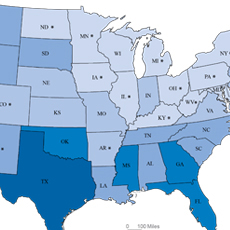 Population Without Health Insurance
Population Without Health Insurance Population Bracketology
Population Bracketology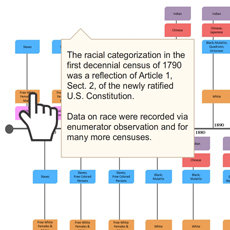 Measuring Race and Ethnicity Across the Decades: 1790-2010
Measuring Race and Ethnicity Across the Decades: 1790-2010 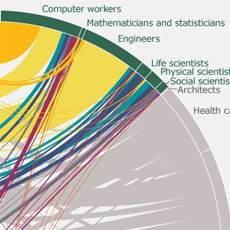 Where do college graduates work?
Where do college graduates work? Story Maps Illustrate Population Change
Story Maps Illustrate Population Change HIV/AIDS Impact in Africa
HIV/AIDS Impact in Africa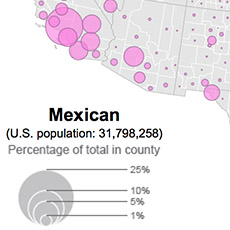 Distribution of Hispanic or Latino Population by Specific Origin: 2010
Distribution of Hispanic or Latino Population by Specific Origin: 2010 A Century of Population Change in the Age and Sex Composition of the Nation
A Century of Population Change in the Age and Sex Composition of the Nation 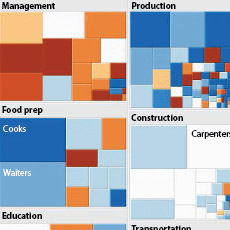 Shifting Occupational Shares
Shifting Occupational Shares Metro Area Density
Metro Area Density Work-Life Earnings
Work-Life Earnings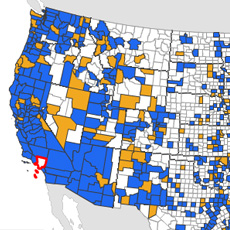 Census Flows Mapper
Census Flows Mapper Migration Between Calif. & Other States
Migration Between Calif. & Other States U.S. Territory and Statehood Status
U.S. Territory and Statehood Status Spoken Languages Other than English
Spoken Languages Other than English Center of Population, 1790-2010
Center of Population, 1790-2010 Population Change by Decade
Population Change by Decade Without A High School Education
Without A High School Education A Decade of State Population Change
A Decade of State Population Change State-to-State Migration for States of 8 Million or More
State-to-State Migration for States of 8 Million or More Population Under 5 Years Old by Congressional District
Population Under 5 Years Old by Congressional District Components of Metro Area Change
Components of Metro Area Change Blooming States
Blooming States Coastline County Population
Coastline County Population Coastline County Population
Coastline County Population I-90 Population Density Profile, 2010
I-90 Population Density Profile, 2010 Second Cities: Keeping Pace with a Booming New York
Second Cities: Keeping Pace with a Booming New York By the Grid: Population Shift to the West and South
By the Grid: Population Shift to the West and South I-10 Population Density Profile, 2010
I-10 Population Density Profile, 2010 Booming Cities Decade-to-Decade, 1830-2010
Booming Cities Decade-to-Decade, 1830-2010 I-5 Population Density Profile, 2010
I-5 Population Density Profile, 2010 Islands of High Income
Islands of High Income The Great Migration, 1910 to 1970
The Great Migration, 1910 to 1970 Following the Frontier Line, 1790 to 1890
Following the Frontier Line, 1790 to 1890 Changing Ranks of States by Congressional Representation
Changing Ranks of States by Congressional Representation Cartograms of State Populations in 1890, 1950, and 2010
Cartograms of State Populations in 1890, 1950, and 2010 Before and After 1940: Change in Population Density
Before and After 1940: Change in Population Density From Physical to Political Geography
From Physical to Political Geography Differential City Growth Patterns
Differential City Growth Patterns I-95 Population Density Profile
I-95 Population Density Profile Increasing Urbanization
Increasing Urbanization Gaining and Losing Shares
Gaining and Losing Shares Top 20 Cities
Top 20 Cities




